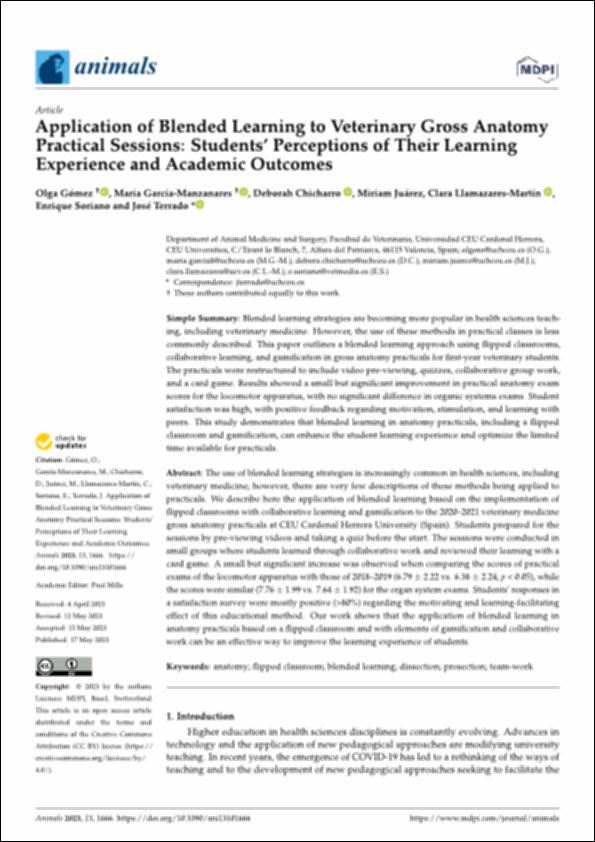Please use this identifier to cite or link to this item:
http://hdl.handle.net/10637/14954Application of blended learning to veterinary gross anatomy practical sessions: students’ perceptions of their learning experience and academic outcomes
| Title: | Application of blended learning to veterinary gross anatomy practical sessions: students’ perceptions of their learning experience and academic outcomes |
| Authors : | Gómez Roda, Olga García Manzanares, María Dolores Chicharro Alcántara, Deborah Juárez Cuevas, Miriam Llamazares Martín, Clara Soriano Zuriaga, Enrique Terrado Vicente, José |
| Keywords: | Anatomía; Anatomy; Veterinaria; Veterinary medicine; Aprendizaje semipresencial; Blended learning |
| Publisher: | MDPI |
| Citation: | Gómez, O., García-Manzanares, M., Chicharro, D., Juárez, M., Llamazares-Martín, C., Soriano, E., & Terrado, J. (2023). Application of blended learning to veterinary gross anatomy practical sessions: students’ perceptions of their learning experience and academic outcomes. Animals, vol. 13, i. 10, art. 1666 (17 may.). DOI: https://doi.org/10.3390/ani13101666 |
| Abstract: | The use of blended learning strategies is increasingly common in health sciences, including veterinary medicine; however, there are very few descriptions of these methods being applied to practicals. We describe here the application of blended learning based on the implementation of flipped classrooms with collaborative learning and gamification to the 2020–2021 veterinary medicine gross anatomy practicals at CEU Cardenal Herrera University (Spain). Students prepared for the sessions by pre-viewing videos and taking a quiz before the start. The sessions were conducted in small groups where students learned through collaborative work and reviewed their learning with a card game. A small but significant increase was observed when comparing the scores of practical exams of the locomotor apparatus with those of 2018–2019 (6.79 ± 2.22 vs. 6.38 ± 2.24, p < 0.05), while the scores were similar (7.76 ± 1.99 vs. 7.64 ± 1.92) for the organ system exams. Students’ responses in a satisfaction survey were mostly positive (>80%) regarding the motivating and learning-facilitating effect of this educational method. Our work shows that the application of blended learning in anatomy practicals based on a flipped classroom and with elements of gamification and collaborative work can be an effective way to improve the learning experience of students. |
| URI: | http://hdl.handle.net/10637/14954 |
| Rights : | Open Access http://creativecommons.org/licenses/by/4.0/deed.es |
| ISSN: | 2076-2615 (Electrónico) |
| Issue Date: | 17-May-2023 |
| Center : | Universidad Cardenal Herrera-CEU |
| Appears in Collections: | Dpto. Medicina y Cirugía Animal |
Items in DSpace are protected by copyright, with all rights reserved, unless otherwise indicated.


